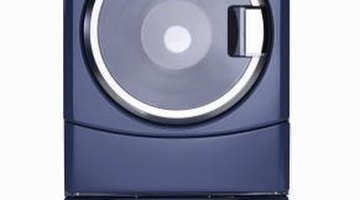Difference Between an Outlet for an Electric Range & a Dryer
The electrical setup of an electric range and electric clothes dryer in your home is more dependent on the electrical wiring of the home than of the appliances. Electric appliances are designed to be easily switched between the types of outlets or wiring setups that may be available in different homes.
Appliance Voltage

Electric dryers and kitchen ranges use the same type of electric power. The manual or tag on the appliance will usually list the requirements as 208- or 240-volt single-phase electricity. Residential homes usually receive 240-volt-rated electricity from power companies, and 208-volt power is usually supplied to commercial businesses. The wiring, circuit breaker, outlet and plug options are the same for either voltage rating. Most homeowners can assume they have 240-volt power for the use of high-voltage appliances.
240-Volt Outlets
The outlets in a home providing 240-volt power will be either a three- or four-prong receptacle. The outlets are larger than the regular 120-volt outlets in the rest of the home. The three-prong outlet is the older style and will only be in older homes. New home wiring rules require the use of the four-prong outlets. Most homes will have a 240-volt outlet installed where the washer and dryer are expected to be housed. In the kitchen, if there is an outlet for an electric range, it will be the same type as for the dryer installation.
Appliance Cords
New ranges and clothes dryers do not come with a power cord. The appliance manufacturer does not know what type of outlet will be in a home, and, therefore, ships appliances without cords. Appliance cords with either a three- or four-prong plug are available at appliance, hardware and home improvement stores. Purchase the correct cord for the type of outlet in the home. If a dryer or stove is moved to a different home with a different type of outlet, a new cord can be purchased with the correct plug. The cords are easily installed and the appliance can then be used in the new home.
Electric Range Wiring
If there is no outlet installed in a kitchen for an electric range, the builder may have intended for an electric stove, oven or range to be hardwired directly into the electrical system. Built-in stoves and ovens are usually hardwired without the use of an outlet. If the kitchen was set up for a freestanding electric range, there will probably be a 240-volt outlet for the range. A freestanding range can be hardwired in the same manner as the built-in types. If the kitchen does not have an outlet, having an electrician hard wire the range may be the lower-cost option.
References
Writer Bio
Tim Plaehn has been writing financial, investment and trading articles and blogs since 2007. His work has appeared online at Seeking Alpha, Marketwatch.com and various other websites. Plaehn has a bachelor's degree in mathematics from the U.S. Air Force Academy.
Photo Credits
- Ryan McVay/Photodisc/Getty Images
More Articles



